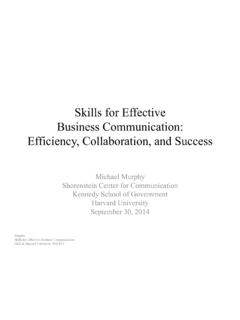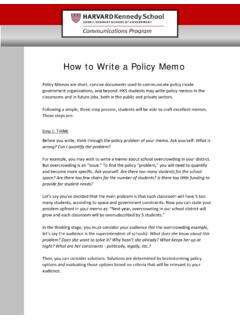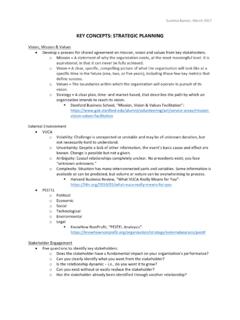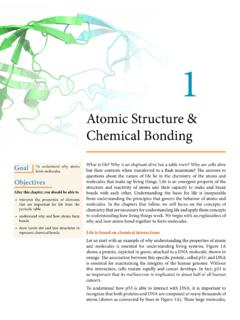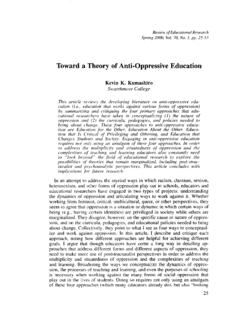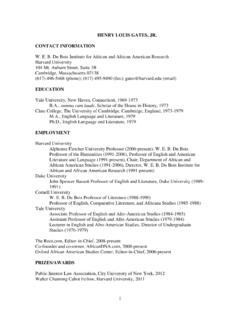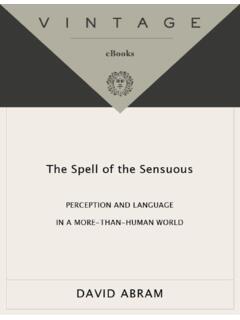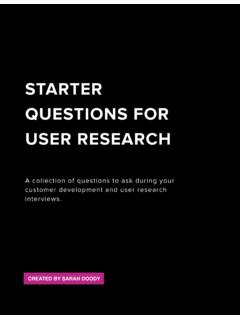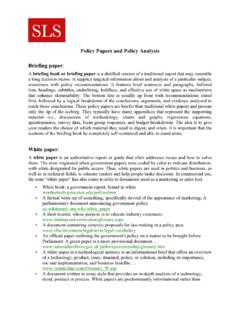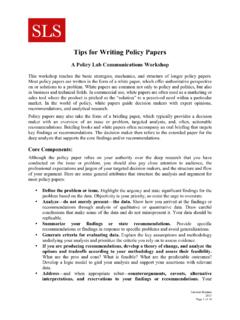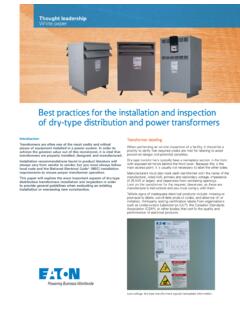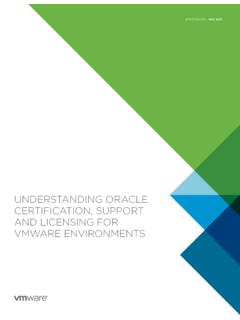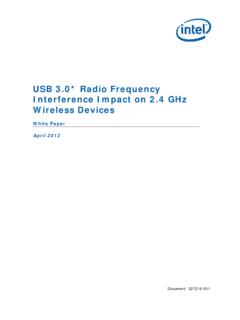Transcription of White Papers and Briefing Books - Harvard University
1 White Papers and Briefing Books A Communications Program Workshop This workshop teaches the basic strategies, mechanics, and structure of longer policy Papers and Briefing Books . A White paper is an authoritative report that offers solutions to a problem. White Papers are common not only to policy and politics, but also in business and technical fields. In commercial use, White Papers are often used as a marketing or sales tool where the product is pitched as the solution to a perceived need within a particular market. In the world of policy, White Papers guide decision makers with expert opinions, recommendations, and analytical research.
2 A Briefing book provides a decision maker with an overview of an issue or problem, guiding policy with recommendations or with deep background and analysis. Briefing Books are often accompanied by short memos and oral briefings that glean important findings or recommendations. The decision maker then refers to the extended Briefing book for the deep analysis that supports the core findings and/or recommendations. Core Components: Both the White paper and the Briefing book rely on your authority over the deep research that you have conducted on the issue or problem and they share many analytical features. The two genres, however, are distinguished by audience, and the structure and flow of information.
3 While the Briefing book is more immediately concerned with the precise needs, expectations, and concerns of the decision-maker, the White paper is more typically written for a broader audience. These following guidelines should help direct your analysis for both genres. Define the problem or issue. Highlight implications or state significant findings based on the data. Analyze do not merely present the data. Show how you arrived at the findings or recommendations through analysis of qualitative or quantitative data. Draw careful conclusions that make sense of the data and do not overstate or misrepresent it. Summarize your findings or state recommendations.
4 Provide specific recommendations or findings in response to specific problems and avoid generalizations. Generate criteria for evaluating data. Explain the key assumptions and methodology underlying your analysis and prioritize the criteria you rely on to assess evidence. If you are producing recommendations, analyze the options according to your methodology and assess their feasibility. What are the pros and cons? What is feasible? What are the predictable outcomes? Support your assertions with relevant data. Address and when appropriate rebut counterarguments, caveats, alternative interpretations, and reservations to your findings or recommendations.
5 Your credibility as a policy maker relies on your ability to locate and account for counterargument. You should be especially sensitive to the likely counterarguments your decision-maker faces in implementing or acting on your recommendations or findings. Luciana Herman 2012. Page 1 of 9. Suggest next steps and/or implementation of the findings or recommendations. Briefly address the feasibility of those next steps or the implementation. Distill the conclusions succinctly in a concluding section and remind the decision- maker of the big picture, the overall goal, the necessity of the investigation, or of the urgency for action.
6 This answers the so what? question that reminds the decision- maker of the value of the research and recommendations. It should reflect the decision- maker's primary concerns. Adapted from Marie Danziger, Option and Decision Memos: Basic Components, 1988. Locating Recommendations in Competing Data: The Option and Decision Feasibility Chart and the PEST Matrix After you have produced findings on the problem, you must orient the data around likely solutions. The Option and Decision Feasibility Chart and a PEST Analysis are essential starting points in locating recommendations from competing data and perspectives. PEST focuses on how political, economic, social, and technological factors affect the feasibility of a recommendation option.
7 Examples of political factors could include applicable regulations, taxation issues and government policies. Economic factors include inflation, business cycles, government spending, and overall cost, and consumer confidence. Social factors include demographics, public attitudes, and income distribution. Technological factors focus on the technology involved in supporting or implementing a recommendation, including energy use and the availability of key technology. PEST analysis involves not only identifying the relevant factors, but also considering options for responding to these influences. There are two primary formats of PEST analysis for policy makers, which each offer starting points from which you can drill down to increasingly detailed conclusions and recommendations.
8 The first example chart shows the variability in a strong PEST analysis, breaking it into five categories to assess the feasibility of implementing four recommendation options: Political Feasibility, Administrative Feasibility, Equity, Cost Effectiveness, and Environmental Impact. That chart also shows that the policy writer folded Social Feasibility into the Political Feasibility and Equity tests. The example chart focuses on the problem of pesticides, offering four possible solutions to deal with the problem: (1) Do Nothing/Status Quo, (2) Tax Pesticides, (3) Increase Number of Pesticides Banned, (4) Discourage Pesticides through Tax Breaks to Ecologically Appropriate Crops, (5) Limit the Number of Pesticides that can be applied to a particular crop.
9 The chart then assesses the overall positive and negative outcomes or qualities associated with each possible solution to reveal a dominant recommendation: Tax Pesticides. You can build your own Feasibility Chart by measuring recommendation options in the context of PEST categories and through the perspectives of key interest groups. The more detailed your knowledge of your subject, the more authoritative the outcome of the chart. In this chart, the policy writer prioritizes five hypothetical solutions to the problem of pesticide use: Luciana Herman 2012. Page 2 of 9. Options Do Nothing/Status Quo - + - - +/- Tax Pesticides +/- + +/- + +.
10 Increase Number of Pesticides +/- - - + - Banned Discourage Pesticides through Tax - - +/- + +/- Breaks to Ecologically Appropriate Crops Limit the Number of Pesticides - +/- - +/- +/- Used on Certain Crops Criteria Political Administrative Equity Environmental Impact Economic Impact/Cost Feasibility Feasibility Effectiveness The PEST chart shows that, while all five possible recommendations have positive environmental impact, only one of the options predominates among the other criteria. In this policy researcher's view, taxing pesticides meets the bar of being administratively feasible and equitable to all parties; it has a positive environmental impact and it is both cost effective and offers a positive economic impact.

